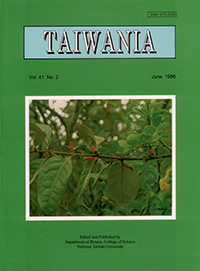Research Paper
Salt-Stress Induces Lipid Degradation and Lipid Phase Transition in Plasma Membrane of Soybean Plants(1)
Chi-Ying Hunag
Published on: June 1996
Page: 96 - 104
DOI: 10.6165/tai.1996.41.96
Abstract
Soybean seedlings were grown under NaCl-stress and non-stress conditions. To induce salt stress, the water potential of Hoagland solution, which was used to culture the soybean plants, was adjusted to -1.6 MPa daily with saturated NaCl solution. Leaf plasma membranes were isolated and assayed for lipid content, phospholipid class composition, and the fatty acid composition of total phospholipids of plasma membranes. Lipid phase transition temperature and lipoxygenase activity were also measured. The plasma membrane contained a higher concentration of phospholipid than that of glycolipid. The phospholipid(PL) contained higher contents of saturated fatty acids than that of unsaturated fatty acids. Under salt-stress, the ratio of saturated/unsaturated fatty acids became higher, and the enthalpy of lipid phase transition in leaf plasma membranes was raised . A large increase in the lipoxygenase activity in salt-stressed plasma membranes may have contributed to the decline in PL. These results suggest that the plasma membrane of leaves from soybean plants grown under the salt-stress became solidified, and this solidification of the plasma membrane might be the limiting factor that restricts plant growth under salt-stress environments.
中文摘要
大豆生長於鹽逆境情況下,其葉細胞膜中磷脂濃度比醣脂及中性脂的濃度高。而磷脂中所含的飽和脂肪酸濃度增加,而不飽和脂肪酸的濃度反而相對減低。不飽和脂肪酸濃度的減低與 Lipoxygenase 活性的增加有關。由於鹽逆境情況下,此酵素分解不飽和脂肪酸活性的增加,及飽和脂肪酸濃度的提高,使飽和脂肪酸的濃度與不飽和脂肪酸的濃度的比例增加。另外細胞膜的脂質 Enthalpy 也有增加的現象。這些結果顯示出,大豆生長於鹽逆境情況下其脂質相有改變的現象,也就是細胞膜有固體化的現象。而此細胞膜的固體化作用,導致細胞失去其對水分或養分滲透壓的調控作用,這才是致使植物不能生長於鹽逆境土壤中的主要因素。
Keyword: Salt-stress, Phospholipid, Fatty acid, Lipid-phase Transition, Lipoxygenase


